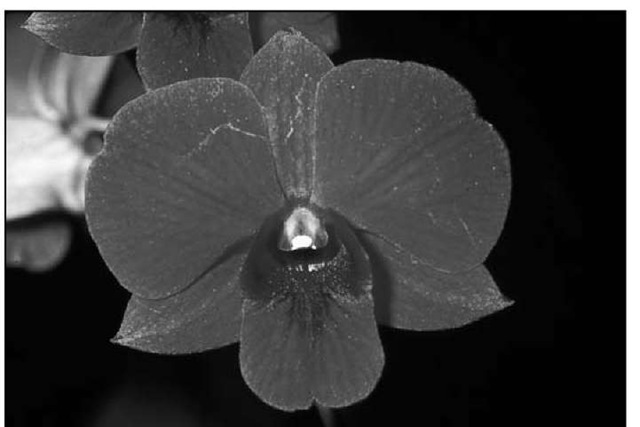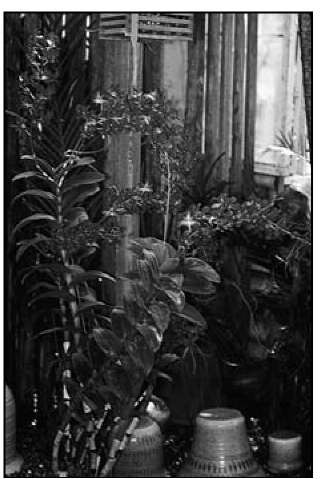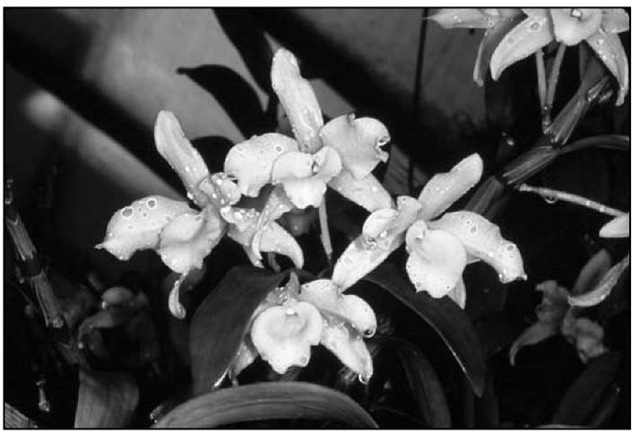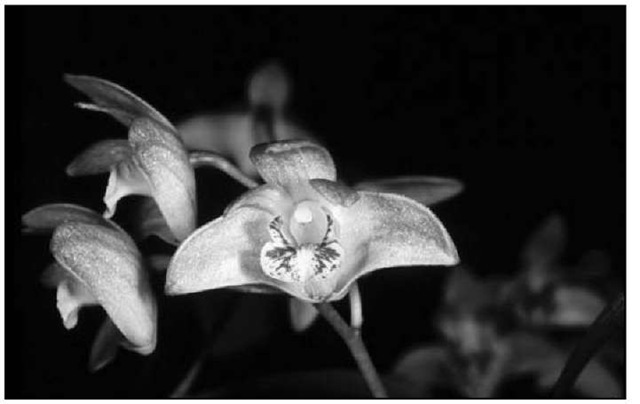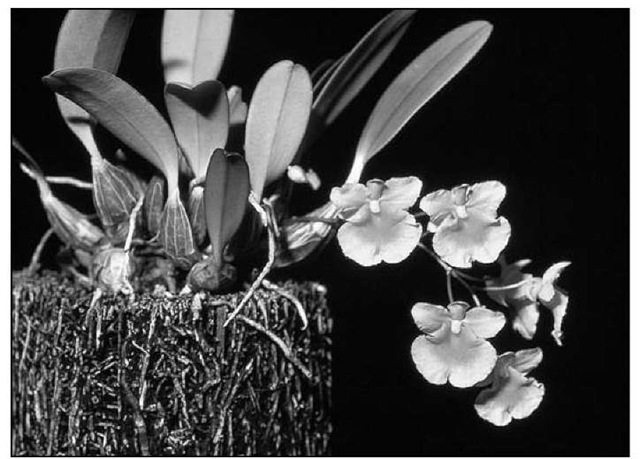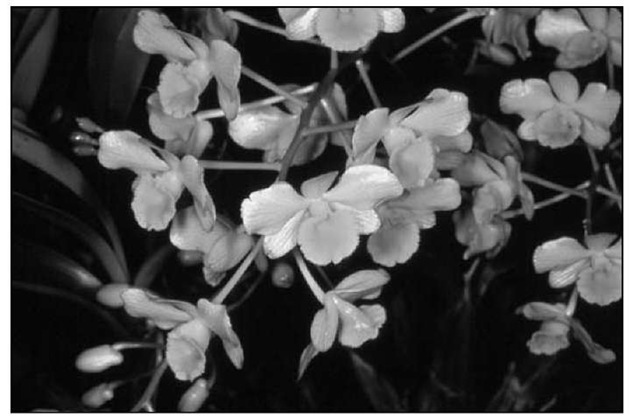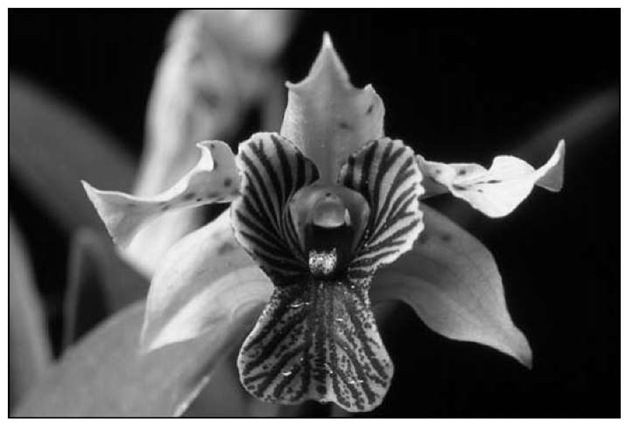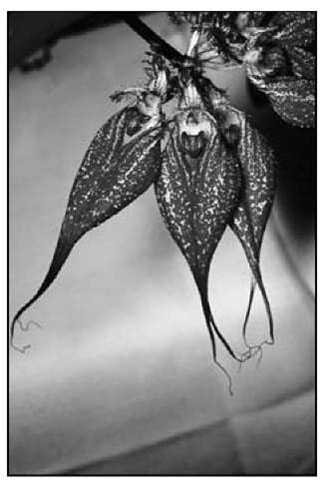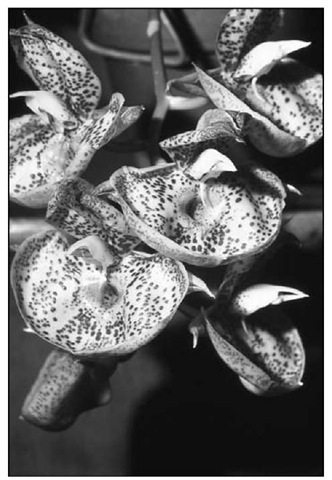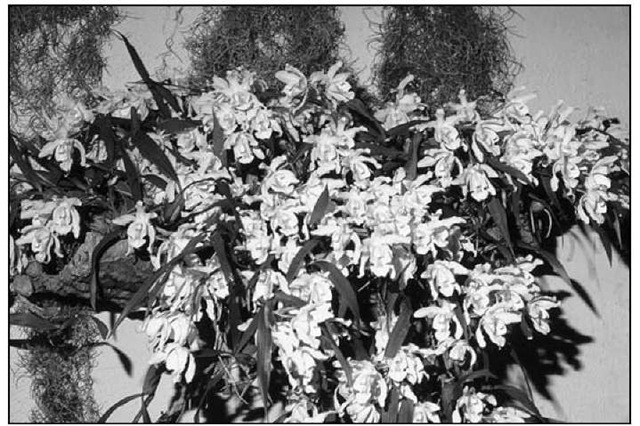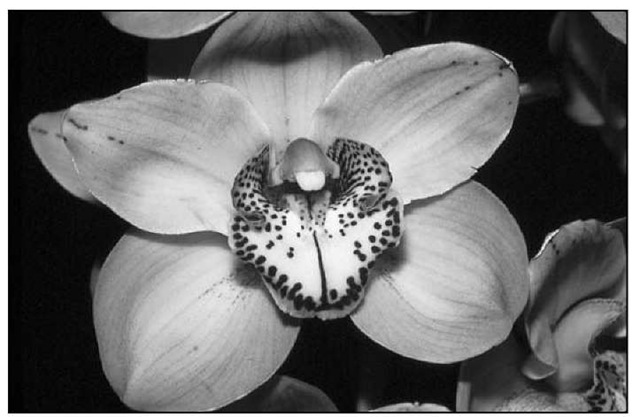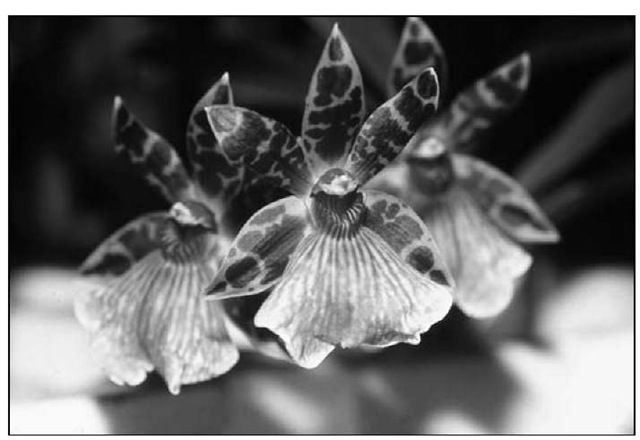In This Topic
- Discovering one of the biggest of all groups of orchids: Dendrobiums
- Finding orchids that are as weird as they get: Bulbophyllums
- Considering some other orchids
In the previous topics, I present you with some of the largest orchid groups that are most suitable for home orchid growing. But, as you can imagine, with tens of thousands of different orchids out there, some additional ones in other groups are also prime candidates. In this topic, I give you a glimpse at some of them.
A Huge and Interesting Lot: Dendrobiums
Dendrobiums and their close relatives number more than a thousand. They call their homes the old-world tropics, which include New Guinea and the exotic land down under, Australia. Some of these orchids have exacting cultural requirements that are a challenge to provide. The ones I show you here are the easier ones that have basically the same cultural requirements as cattleyas — medium to high light, modest humidity, and intermediate temperatures. Many of the dendrobiums naturally undergo a drier winter than summer, so they appreciate the same treatment from you. Some are evergreen (keeping their foliage year-round), while others are deciduous (dropping their leaves in the fall) as they enter a rest for the winter, then put out their new growth in the spring.
The most popular dendrobiums
Here is a small selection of some of the easiest and most readily found dendrobiums that are not very demanding. As you become familiar with this huge group of plants, you’ll surely find others you’d like to try out.
Dendrobium phalaenopsis
Although the more proper name for this orchid is Dendrobium bigib-bum, it rarely goes by this in the trade. I list this one first because it is by far the most popular and commonly found dendrobium. Luckily, it is also one of the least expensive and easiest to grow. Hybrids of this type are found in an impressive array of color combinations and are usually about 1)2 to 3 inches (3 to 7 cm) across and look much like phalaenopsis flowers (thus, the species name of phalaenopsis). Figure 14-1 shows an example of a Dendrobium phalaenopsis. The most common flower colors are white, shades of pink, and purple, but some of the newer offerings have contrasting sepals, petals, and lips in a whole range of pastels.
Figure 14-1: The Dendrobium phalaenopsis flower looks much like a phalaenopsis orchid.
Dendrobium phalaenopsis, which are evergreens, differ dramatically in their growth habits — some are very compact, about 6 inches (15 cm) tall while others can reach 3 feet (1 meter) or more in height (see Figure 14-2).
Like most dendrobiums, the Dendrobium phalaenopsis prefers to be pot-bound, so it’s content to stay in a small container. It requires a modest drying-off period during the winter and early spring to promote flowering. You can resume regular watering when new growth appears in the spring until after flowering.
Dendrobium phalaenopsis hybrids, sometimes referred to as “cane” Dendrobiums because of their upright stems, can vary tremendously in their growth habits from dwarfs to giants. Figure 14-2 shows one of the larger forms.
Figure 14-2: A larger Dendrobium phalaenopsis hybrid.
Dendrobium nobile
Another one of the most popular dendrobiums, the Dendrobium nobile (shown in Figure 14-3) has been hybridized extensively so that today’s varieties come in a carnival of bright colors.
The Dendrobium nobile is deciduous, so when winter approaches, keep it on the dry side. Only water it enough to keep its pseudo-bulbs from shriveling. Let the evening temperatures get down around 50°F to 55°F (10°C to 13°C).
Figure 14-3: Dendrobium nobile var. virginale is a white form of this popular dendrobium.
Some people have described the fragrance of these orchids as being like honey or musk during the day and mown hay at night.
Dendrobium kingianum
This dendrobium is wonderfully tough — it can withstand temperatures down to 35°F (1.6°C) — and easy to grow, and it’s just starting to get its due. This Australian native was once considered a “weed” among some orchid growers, because it is such a rapid grower. Now it’s getting new respect as more people are becoming aware of how easy and forgiving it is to grow and bloom and as many new flower color forms are appearing.
The usual flower is small, up to about 1 to 1)2 inches (2.5 to 4 cm), in shades of pink, borne in 8-inch (20-cm) sprays of about a dozen flowers (see Figure 14-4). The newer selections include dark purple, purple-blue, white, striped, and a whole range of combinations of these. This orchid varies considerable in its growth habit from a few inches (5 cm) to almost 16 inches (50 cm) tall.
This orchid has a range of fragrances from hyacinth to lilac to honey.
Dendrobium kingianum requires a dry, cool winter to bloom dependably. It’s an evergreen orchid that has attractive compact, thick, dark green foliage. It readily forms keikis (baby plants).
Figure 14-4: Dendrobium kingianum has small crystalline flowers that are found in various shades of purple and pink.
Some other Dendrobiums Worth considering
After you’ve cut your teeth on the easier dendrobiums mentioned in the previous section, try some of these:
Dendrobium aggregatum: This orchid and its cousin, Dendrobium jenkensii (shown in Figure 14-5) are dwarf plants that produce showers of 1-inch (2.5-cm) golden yellow, honey-scented flowers with broad, almost heart-shaped lips. The flowers appear in groups of two or three for Dendrobium jenkensii, more for Dendrobium aggregatum, in the spring. The pseudobulbs are small, 1 to 2 inches (2.5 to 5 cm). These plants are frequently grown on slabs and are best not transplanted or divided often. They make their most spectacular display when they become large-sized plants.
Dendrobium bellatulum: This is another miniature plant only reaching about 4 inches (10 cm) tall with one to three 1)2-inch (4-cm) white flowers with orange and red markings in the lip. The flowers have a fresh lemon fragrance.
Dendrobium chrysotoxum: This orchid has butter-yellow, pineapple- or mango-scented, 1-inch (2.5-cm) flowers with fringed lips and a darker orange throat that are displayed on a 12-inch (30-cm) flower spike (see Figure 14-6). The plant is evergreen and a compact grower.
Figure 14-5: Dendrobium jenkensii is a miniature grower that blooms best if it’s transplanted very infrequently.
Figure 14-6: Dendrobium chrysotoxum produces sprays of golden flowers with the scent of tropical fruit.
Dendrobium loddigesii: This is a compact grower that reaches about 6 inches (15 cm) tall. It’s covered in the spring with 2-inch (5-cm) light-pink flowers with light-yellow lips that last about three weeks. It has a rambling habit, so it’s most suited for mounting on a slab.
Dendrobium scabrilingue: This miniature, growing only 3 to 5 inches (8 to 15 cm) high, has been in bloom for me for months! Its starry white 1-inch (2.5-cm) flowers have a touch of light yellow in the center with a pleasant sweet fragrance that reminds me of the white paste we used to use in elementary school for our art projects.
Dendrobium lawesii: This is a screamer from the jungles of New Guinea with 1-inch (2.5-cm) bright red-orange, waxy flowers, tipped in yellow that are borne on leafless stems. It’s found in several color forms and its floral brilliance and sweet scent make it in high demand. It needs a drier rest period during the winter. See the color photographs in the center of this topic for an example.
Thousands of dendrobium hybrids exist, but many of them are best suited for a very cool greenhouse. In the following list, I focus on a few that are particularly easy and are a reasonable size to handle:
Dendrobium Andre Millar (frequently misspelled “Miller”): Exotic green 1/2-inch (4-cm) flowers, with lips prominently veined in dark maroon, make this orchid a standout (see Figure 14-7). It apparently comes in two forms: one very compact, about 6 to 8 inches (15 to 20 cm) tall, and the other about twice or more this height. So if plant size is important to you, be sure to ask which form you’re buying.
Figure 14-7: Dendrobium Andre Millar has flowers that have an almost alien look.
Dendrobium Iki: A great miniature that rarely grows higher than 7 inches (20 cm), this orchid has attractive dark green, glossy, evergreen foliage and charming 1-inch (2.5-cm) creamy white flowers with red and orange in the lip. It has the sweet fragrance of licorice.
Dendrobium Jesmond Gem: This dendrobium is merely representative of the many new hybrids that are coming into the United States from Australia. They’re usually tough plants that can survive temperatures approaching freezing and, in fact, will usually bloom best if given a very cold period in the neighborhood of 40°F to 49°F (4°C to 8°C). If you have a very cool bright spot, be on the lookout for these fine hybrids. Jesmond Gem has pristine white, 2-inch (5-cm) sweet-smelling flowers with purple specks on the lips and yellow stripes down the center of the lips. It grows about 18 inches (45 cm) tall.
Weird and Wonderful Relatives: Bulbophyllum
One of the many great aspects of the orchid world is that, with their seemingly countless species and hybrids, there is an orchid out there that meets absolutely anyone’s fancy! For those who pursue the bizarre, otherworldly, and sometimes malodorous, bul-bophyllums fill the bill perfectly. You have to see (or smell) these oddities to believe that they could exist. Many are carrion flowers, ones that smell like rotting meat; this is to attract their primary pollinators, various types of flies. Here are a few of the outstanding ones that are not particularly difficult to grow:
Bulbophyllum beccarii: Contrary to the other orchids in this topic, this one is very difficult to grow, but I simply had to let you know about it because it is the “grande stinko” of the orchid world. This orchid is described as smelling like “100 dead elephants rotting in the sun.” This is not one you want to have in your living room! It’s considered to be one of the most spectacular bulbophyllums, if you can stand the stench. Its leaves grow up to 2 feet (60 cm), so it’s usually grown mounted, and it has small brown flowers with a purple blush.
Bulbophyllum echinolabium: Displaying a dramatic flower that can be 1 foot (30 cm) or more long, this bulbophyllum has a dark-cream flower with mahogany stripes. It’s a compact grower of about 6 to 8 inches (10 to 15 cm) tall (see Figure 14-8).
Bulbophyllum odoratissimum: A miniature bulbophyllum that grows to about 3 inches (8 cm), this orchid has petite flowers of a dozen or more. The flowers are yellow with a reddish brown lip and actually smell pleasant.
Bulbophyllum lobbii: A jasmine-scented species, this orchid is referred to as the “Queen of Bulbophyllums.” The 3- to 4-inch (7.5- to 10-cm) yellow flowers with purple mottling are borne singly. The leaves are spatula-shaped and about 12 inches (30 cm) long.
Bulbophyllum phalaenopsis: This is another stinker. It has huge leaves up to 4 to 6 feet (120 to 180 cm) long, shaped like those of phalaenopsis (thus, the species name). Its flowers are dark red with yellow protuberances. This huge plant is really only happy in a greenhouse. See the “Being stinky has its rewards” sidebar for more information.
Bulbophyllum rothschildianum: One of the most spectacular of the bulbophyllums, this orchid has five or six flowers in a cluster. Each flower is about 1 inch (2.5 cm) wide and 7 inches (17.5 cm) long. The flowers have yellow bases covered with dark red and darker maroon lips. The plants grow about 12 inches (30 cm) high (see Figure 14-9).
Figure 14-8: Bulbophyllum echinolabium has a 1-foot-long (30-cm-long) flower, which makes it one of the largest in the genus.
Figure 14-9: Bulbophyllum rothschildianum has one of the most magnificent flowers of all bulbophyllums.
Being stinky has its rewards
At the highly prestigious 2004 New York International Orchid Show, a gigantic mounted specimen of Bulbophyllum phalaenopsis shared the top honor with one other orchid to be Co-Grand Champion and also received a Certificate of Cultural Excellence from The American Orchid Society. This plant was said to be valued at thousands of dollars!
Orchid Miscellanea: All the Rest
Having to give the rest of these fascinating orchids such little coverage is a shame, but with so many orchids and so little space. . . . In the following sections, I give very brief introductions to some example plants in other genera that deserve your attention.
Catasetum
Looking closely at the shape of its showy flowers, you can see how the catasetum got tagged with its common name: Monkey Goblet. Many hybrids of this orchid are available, and they’re relatively easy to grow.
Catasetums are deciduous orchids, which means they like to be watered and fertilized copiously when they’re in active growth, and then kept on the dry side during the winter — stop watering for four to six weeks — until they start new growth in the spring.
Catasetum Orchidglade was the first commercial catasetum hybrid. This selection has up to 15 2-inch (5-cm) creamy white, thick, waxy flowers that are covered with red freckles. It has a spicy fragrance and, like other catasetums, is usually grown in a basket. It prefers rapid drainage; the flowers are borne on pendulous sprays at the bottom of the plant (see Figure 14-10).
Cochleanthes
This is a beguiling genus of orchids that is starting to get more exposure. Cochleanthes have very attractive glossy green foliage, usually bloom more than once a year, are easy to grow (preferring the same growing conditions as phalaenopsis), and have exotic flowers.
Figure 14-10: Catasetum Orchidglade has pendulous flowers and pleated foliage typical of catasetums.
Cochleanthes amazonica has white, 2-inch (5-cm), rose- or candy-scented flowers with vivid dark purple veins on the impressive flared lip. A hybrid of this species, called Amazing, has very similar, but somewhat larger flowers (see the color photographs in the center of this topic for an example). The plant grows about 8 inches tall.
Be sure to keep the potting material damp or the leaves will become pleated.
Cochleanthes discolor is another fine species that has 2-inch (5-cm) cream-colored flowers with a mauve cupped lip. It grows about 8 inches (20 cm) tall and has a cedar or candy fragrance.
Cochleanthes Moliere is a hybrid of Cochleanthes amazonica and Cochleanthes discolor. It is a marriage with a spectacular result: 2-inch (5-cm) flowers with white petals tipped with pink, and a huge, contrasting, dramatic purple lip.
Coelogyne
A genus of about 100 species found in Asia, coelogyne orchids are usually fragrant. Most of them do best in medium to high light in intermediate temperatures; some from mountainous areas like it cooler. Most of them grow and look best when they’re permitted to grow to a large size, not divided.
Coelogyne cristata is one of the popular species of this group. It displays white, banana-scented flowers that are about 3 inches (8 cm) wide with a white lip with yellow markings.
Because of its rambling habit, Coelogyne cristata is best grown into a large plant in a basket or mounted (see Figure 14-11). Coelogyne intermedia has white fruity-scented flowers with a yellow throat and grows to about 8 inches (20 cm) tall. Coelogyne intermedia should be kept on the damp side, or the foliage will become pleated.
Figure 14-11: Coelogyne cristata makes a beautiful sight as a large, well-grown plant.
Cymbidiums
Cymbidiums are popular as corsage orchids because they last for such a long time, even after they’ve been cut from the plant. Thanks to modern orchid breeding, these orchids are now available in a vast array of colors — some with markings on the lips, others with totally clear flowers and lips. The ones that most people are familiar with are the “standard” cymbidiums.
A full-size plant in complete flower is a jaw dropper. However, these plants can get 2 to 4 feet (60 to 120 cm) or more tall and wide — they’re serious space hogs. Also, some of the standard varieties require very cool and bright conditions for them to perform at their best.
The most common complaint of amateur cymbidium growers is that the plants grow fine, but they don’t flower. If this sounds familiar, you’re probably giving your cymbidium too little light or not giving it the cool evening temperature of 45°F to 50°F (7°C to 10°C) that it needs in order to trigger the formation of flower buds.
Newer, more-compact plants with a warmer temperature tolerance are appearing all the time, so life for the hobbyist cymbidium lover is getting easier. These smaller plants are referred to as “miniature,” but be aware that this is a relative term. “Miniature” cymbidiums still reach about 2 feet (60 cm) tall but can be managed in a 6- to 8-inch (15- to 20-cm) pot.
Standard cymbidium hybrids are very popular as outside orchids in mild areas like Southern California. They’re grown successfully in many places as long as they have enough light, cool evenings, and space. The newer ones, such as Cymbidium Solana Rose (shown in Figure 14-12), have very full, round flowers.
Figure 14-12: Cymbidium Solana Rose is a soft pink standard variety that exemplifies the new hybrid cymbidiums with large round flowers in pastel shades.
Cymbidium Golden Elf is a 2/2-inch (6-cm) clear bright-yellow-flowered miniature variety with four to six flowers per spike. Its size is more manageable for most home growers. This one can bloom several times a year and is more tolerant of warmth. The lightly rose-scented flowers last for about two weeks.
Lycaste
A deciduous plant, lycaste orchids have pleated foliage and triangular flowers. Many of them have a tantalizing fragrance. They like good air circulation, cool evenings of 45°F to 55°F (7°C to 13°C), and frequent and heavy waterings during the summer growing season. They should be kept on the dry side during the winter.
Lycaste Aquilea ‘Detente’ FCC/AOS is a prize-winner with a 4-inch (10-cm) peachy colored flower that has a sweet floral fragrance.
Lycaste aromatia has sunny lemon yellow, cinnamon-scented, 2)2-inch (6-cm) flowers borne in groups of up to 30 or 40 on a compact plant — all of which makes this easy-to-grow species very popular.
If Lycaste aromatia is grown in bright light, the flowers have a more intense color.
Zygopetalum
Oh, what a heavenly fragrance these have! When only one flowering zygopetalum plant is in a room, it smells like a bed of hyacinths. Most of the zygopetalums have similar color markings — usually, green petals barred in dark maroon or brown with a very broad and prominent white lip with dark purple or pink (see Figure 14-13). They’re easy to grow and perform well on an eastern or southern windowsill.
Figure 14-13: A zygopetalum hybrid with typical markings.
